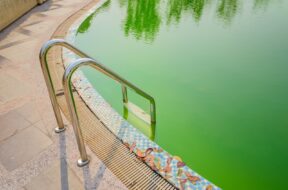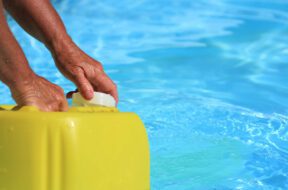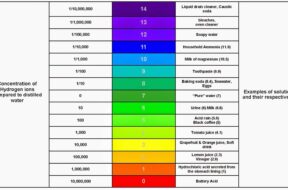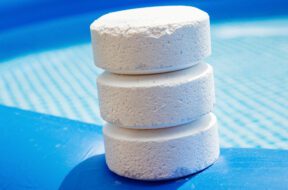
Want to learn more about algaecide? Read on to find out when to add algaecide to your pool maintenance routine and other helpful tips.
When it comes to maintaining clean, clear, and healthy pool water, there is no chemical more important the chlorine. However, chlorine the effectiveness of chlorine is dependent on other chemical and environmental factors of your pool as well. Two of the most important factors are UV rays from sunlight and cyanuric acid (CYA), commonly referred to as stabilizer.
In this article, we dive into the relationship between chlorine and cyanuric acid, and how it stabilizes the amount of free chlorine required for your pool. You may also want to learn about The Relationship Between Pool Chlorine and pH.
Chlorine is a naturally occurring element, with atomic number 17. Chlorine is used in water treatment because of the unique way in which it interacts with water to fight harmful bacteria and other contaminants. When chlorine is added to water, it interacts to form hypochlorous acid, hypochlorite ions, and hydroxide (assuming the pH of the water is between 6 and 9). Both hypochlorous acid and hypochlorite are capable of fighting bacteria. Hypochlorous acid just happens to be 80-100 times better at it. Hypochlorous acid is neutrally charged, which allows it to easily bond with negatively charged bacteria. It then oxidizes the bacteria’s protein cells, which renders the bacteria harmless.
When chlorine is added to pool water, it is in either one of two states: freely available to fight bacteria or combined with bacteria to form chloramines, which remaining free chlorine will then neutralize. The former is referred to as free chlorine. The latter is referred to as combined chlorine. The sum of free chlorine and combined chlorine is referred to as total chlorine. It’s important to maintain sufficient free chlorine levels to ensure there is enough to fight an new bacteria that arises.
When we think of how free chlorine gets used up, we typically only think about how it combines with bacteria to neutralize the risk of swimmers getting sick. However, there is another culprit responsible for dissipating free chlorine. That culprit is energy from the sun in the form of UV light. When UV light, like that from the sun, interacts with free chlorine, it causes the free chlorine to undergo a photochemical reaction called photolysis. In simple terms, what happens is that the chlorine (and hydrogen, in the case of hypochlorous acid) separates from the oxygen due to the energy introduced by the UV light. Without oxygen, the chlorine cannot oxidize the bacteria protein cells. Therefore, the chlorine becomes worthless in the fight against contaminants in the pool water. This happens very quickly. Within 17 minutes of UV light exposure, up to 50% of all free chlorine will undergo photolysis.
Cyanuric acid is a triazine compound that serves as a protective shield around free chlorine to protect against the photochemical effects of UV light. Cyanuric acid is like free chlorine’s superhero sidekick against UV light. By preventing the rapid photolysis of free chlorine, cyanuric acid effectively stabilizes the amount of free chlorine in the water. That is why cyanuric acid is commonly referred to as stabilizer.
There is one small catch, however. Cyanuric acid also creates a field of friction between free chlorine and the bacteria the free chlorine aims to obliterate. So, more free chlorine is needed to kill the same contaminants in the presence of cyanuric acid. Still, it is inconsequential in comparison to the photochemical effects of UV light on free chlorine when cyanuric acid is not present.
Cyanuric acid and chlorine are both measured in parts per mil (ppm). A general rule of thumb is to maintain a minimum ratio of 7.5% of free chlorine to cyanuric acid. The World Health Organization recommends an upper limit of 100 ppm of cyanuric acid to prevent adverse health effects. The easiest way to check your cyanuric acid and chlorine levels is with test strips.
If your pool is not exposed to significant amounts of sunlight and you are not using a salt water generator (SWG), we recommend keeping cyanuric acid between 30 and 50 ppm. If your pool is exposed to a lot of sunlight or you are using a SWG, we recommend keeping cyanuric acid between 60 and 80 ppm. When in doubt, 50 ppm is always a safe target to shoot for.
You may adjust your free chlorine levels accordingly, but bear in mind that the Association of Pool and Spa Professionals recommends free chlorine levels be between 2.0 and 4.0+ ppm and the Center for Disease Control recommends a minimum of 1.0 ppm and 3.0 ppm of free chlorine in pools and hot tubs, respectively. When your free chlorine levels get too low, we recommend using calcium hypochlorite to raise them back up.

Want to learn more about algaecide? Read on to find out when to add algaecide to your pool maintenance routine and other helpful tips.

In this quick guide, we’ll answer the question “can you over shock a pool” and unveil the factors to consider when shocking a pool.

Maintaining both pH and total alkalinity in your swimming pool is important for keeping your pool properly sanitized and non-corrosive. Total alkalinity is to pH what cyanuric acid is to free chlorine. Total alkalinity stabilizes pH levels. The ideal pool pH level is 7.4 to 7.6. The ideal total alkalinity level is 80 to 120 ppm.

The Association of Pool and Spa Professionals recommends free chlorine levels for both swimming pools and hot tubs be kept between 2.0 and 4.0 ppm. However, the Center for Disease Control recommends free chlorine stay above 1 ppm in pools and 3 ppm in hot tubs.